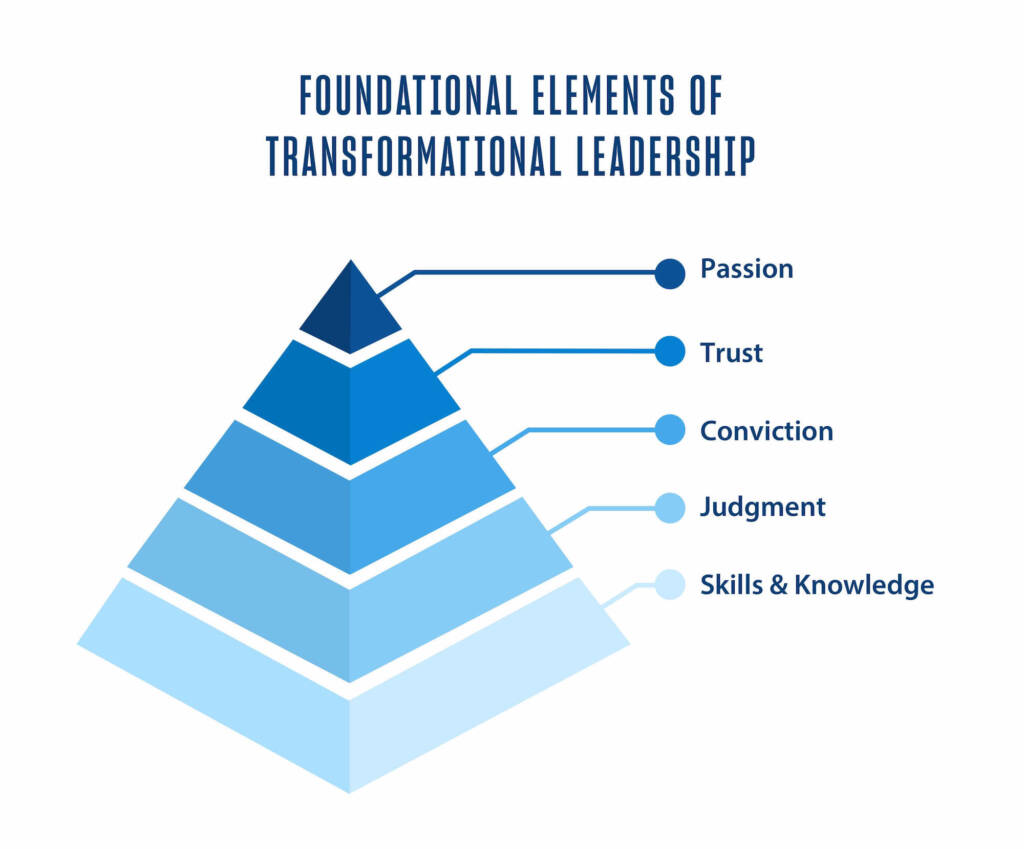In every organization, across all industries, there are many possible approaches to leadership. As a leader, your approach will depend on your organization’s structure, employees and goals — in addition to external factors. While every leadership style has various advantages and drawbacks, transformational leadership might be the best-suited for meeting the challenges of today’s fast-moving and disruptive digital world.
If you’re committed to innovation, disruption and inspiration, here’s what you need to know about this revolutionary leadership style.
What Is Transformational Leadership?
Fundamentally, the transformational leadership approach creates an environment that fosters innovation and encourages change. Every action that a transformational leader takes shapes their organization and helps secure buy-in from other employees and stakeholders. Some hallmarks of the transformational leadership style include:
- Focusing on aligning the organization and its collective goals with a culture of independence, growth and development.
- Establishing a common vision, mission or purpose to outline and define the organization’s goal(s).
- Encouraging, motivating and inspiring employees to take ownership of their work and achieve their goal(s).
- Fostering a culture of employee independence and empowerment, and setting an example for them to follow as they work toward communal success.
In the way that it balances the needs of the individuals and the larger organization, with the goal of enabling communal success, transformational leadership shares some similarities to organizational leadership.
Origins of Transformational Leadership
Transformational leadership was first espoused by James V. Downton in 1973 and then expanded upon in 1978 by James MacGregor Burns. It was Burns who noted that it was the relationship between leaders and followers that pushed each other to greater levels of “moral and motivation” by shifting their beliefs, needs and values.
This initial conceptualization was further developed by organizational change and leadership development expert Kevin Ford and researcher Bernard M. Bass, who argued that transformational leaders raised the awareness of others through vision, self confidence and inner strength.
Over the last 50 years, many changes have reconfigured how we think of transformational leadership. Political and economic changes, like the establishment of the European Union, the USMCA trade agreement and the emergence of China, India and Russia as economic superpowers have led to incredible new opportunities, but also larger considerations of competition, regulations and conflicts. This is further complicated by globally disruptive elements like mass migrations, the climate crisis and the rise of more socially conscious consumers.
One of the most important things we must also account for is the prevalence of new technologies such as the internet, artificial intelligence and cloud computing which have helped to bring about the so-called fourth industrial revolution and the hybrid work environment. With so much having changed since the 1970s, is there a more modern way to define transformational leadership?
How Do We Understand Transformational Leadership Today?
Transformational leadership implies a higher degree of complexity, range of talents and personal investment. No one can produce a compelling, attractive vision within a vacuum. A true transformational leader needs to understand the organization, the industry they’re in, the people they work with as well as the new demands of the global economy — which go beyond technological innovation and include elements such as diversity, equity, inclusion and environmental justice initiatives.
To be a transformational leader requires a strong foundation of knowledge and skills, as well as the judgment to analyze a situation and make informed decisions. But that’s just the base competency — truly transformational leadership also requires the conviction to stomach the consequences of changing the status quo and the ability to communicate and work with colleagues and peers to develop trust. Finally, all of that must come across in a demonstration of passion, to both serve to continually motivate yourself and to inspire others.

Benefits and Challenges of Transformational Leadership
So, why strive for transformational leadership? There are a common few benefits with this approach:
- Transformational leadership promotes a good balance of long-term and short-term goals. It not only considers what must be done, but places that in context with what can and will be done.
- The approach promotes an open space for employees and other stakeholders to more easily communicate new ideas, which can foster new approaches and innovative concepts or initiatives.
- It’s an effective means of establishing trust between employees and management.
- As a result, employees are more likely to feel seen and valued. This can help them be more invested in the organization and more passionate about everyone’s shared success.
Transformational leadership is a way of removing boundaries and going beyond existing structures to consider new approaches, exciting new ideas and technologies. It breaks down old structures, and from that chaos, creates a new order.
However, as exciting as that is, transformational leadership does not necessarily work in all circumstances. It does not fit well within bureaucratic structures, and if forced it may negatively disrupt communication and important hierarchies. Additionally, some employees require greater supervision and guidance to succeed, and providing them with greater freedom and responsibility could make it easier for some to fall short of expectations. Finally, too much of a long-term vision may cause the organization to lose sight of its immediate needs and fall off-track or into inefficiencies.
Transformational Leaders vs. Managers
Transformational leadership is just one leadership style among many, some of which are defined as Democratic, Autocratic, Strategic and Servant. However, transformational leadership is most often compared with transactional leadership because they are so different. Transactional leadership is considered to be rather strict, inflexible in its approach and a form of management that generally does not encourage creativity or innovation.
Managers are expected to follow a routine or set of rules to keep their teams on task. This style of leadership is based on a set procedure or a system of exchanges between the manager and each employee. The manager sets expectations or individual goals, and then the employees will receive positive reinforcement for meeting those goals. This style tends to be more “short term” focused and is effective in completing repetitive tasks in larger organizations.
Transformational Leaders vs. Managers
| Transformational Leaders | Managers | |
|---|---|---|
| Motivations | Achieving goals, engage and navigate through risk | Completing tasks, minimize risk |
| Leadership Style | Big picture, innovate and disrupt | Micromanage, administer resources |
| Goals | Long term, creates value and drives effectiveness | Short term, secure costs and efficiencies |
| Responsibilities | Shared between leaders and the larger team | Mostly focused on leaders and management |
| Needs to know | What and why | How and when |
| Characteristics | Creates its own purpose, promotes and produces new leaders | Follows instructructions, consistent, serves a purpose, predictable |
There’s no value judgment here about which type is necessarily better, as both styles are needed in different situations. However, if you’re in a high leadership position, then it is your responsibility to move the organization forward. You need to become a change maker — and that requires the transformational leadership approach.
Characteristics of a Transformational Leadership Style
In discussing theories about leadership, there’s often an attempt to make leadership characteristics mechanistic — as if they can be predictable, replicable behaviors. In truth, that’s separate from the reality of the situation. These are not really steps to take or boxes to check off, but behaviors that are learned and applied over time. To have a transformational leadership style is to develop a vision that is inspirational, compelling, challenging and attractive — what can be thought of as the ICCA style.
There are several characteristics and behaviors that are common within the transformational leadership style. In general, these include:
- Prioritizing the inspirational motivation of others
- Encouraging employee growth and development
- Training and upskilling new leaders
- Demonstrating high moral standards
- Fostering a sense of communal success and collaboration
- Building and improving communication; being open to feedback
- Modeling a behavior that is open-minded and self-aware
- Prefering to be proactive, flexible and adaptive
If you’re a leader who wants to develop your own ICCA leadership style, then you will need to start with an understanding of your business landscape. You’ll need to focus on how to attain growth and what can be done to differentiate your organization. Specifically, you’re not just looking for a way to outperform competitors, but to make the competition irrelevant. How can you modify the organization in accordance with long-term goals and a greater purpose?
Think of how traditional computer companies like IBM and Dell transitioned from selling hardware products to also offering digital business solutions. Or how brands like Apple and Whole Foods position their stores not just as simple points of sale, but design and position them as destinations and communal experiences — closely tying the identity of the company to their customers’ values.
Examples of Transformational Leadership
To realize transformational leadership, it can be helpful to see examples of how others have enacted it. Consider further reading on these notable individuals who revolutionized their industries and found ways to inspire others.
- Reed Hastings, Netflix
- Steve Jobs, Apple
- Michael Dell, Dell Inc
- Jim Sinegal, Costco
- Akio Morita, Sony
- John Reed, USA-CITIGroup
- Lorenzo Zambrano, Cemex
- Luis Pagani, Grupo Arcor
- Garry Ridge, WD-40
- Daniel Servitje Montull, Grupo Bimbo
How Do We Realize Transformational Leadership?
To develop an ICCA vision requires more than just motivational energy and the willingness to effect change. Many of us live with a sense of anxiety management and can be resistant to change. Being able to produce order out of chaos requires overcoming the challenges of volatility, uncertainty, complexity and ambiguity — commonly understood as VUCA. Overcoming these different challenges requires a holistic approach to your organization. It has to be less of a mechanistic system where everything is set in place, and more of a social system that is more fluid and adaptable.
- Find ways to modify the organizational structure to make things lean, agile and more responsive.
- Modify job descriptions and responsibilities to highlight how they offer different degrees of freedom. Ensure they’re aligned with the larger vision or strategy.
- Motivate your employees and collaborators to act as co-owners of the organization. This is where you foster their self-confidence and trust, granting them the authority to make decisions.
How can you start down the path of transformational leadership? Ultimately, you have to be proactive.
- Begin by defining a vision and purpose. Decide what will be the future of your organization. This vision takes time to develop, so take a step back from the day-to-day operations. You’ll need to perform a careful analysis of different scenarios and potential risks.
- Be sure to think globally — we live in an increasingly connected world in which you can communicate with and operate in every country. Your markets are global, so your thinking must be as well.
- Part of that global reach comes with a consideration of different moral codes. Whenever you’re developing new ventures in areas outside of familiar territory, you must consider how you’ll understand and address the different legal, religious or cultural values you may encounter.
- Identify the motivation factors of all stakeholders and customers, and try to understand what’s driving them. This should involve a consideration of emerging trends, including everything from digital information and connectivity to the environment and justice.
- You will need to build a team that shares in your guiding vision. If your vision is seen as too radical, then perhaps it’s time to do a little organization surgery and find new leaders. You must have a structure that is flexible enough to support that passion and vigorous behavior.
- Ultimately, even if more power and decision making is shared among a team, as the leader you must take responsibility. You must be accountable for your decisions. When something is assumed to be the responsibility of everybody, it is the result of nobody.
The world has been through much since the initial idea of transformational leadership. Even now we face an emergency transition to new environments. But now true leaders have an incredible opportunity to transform their organizations and bring order out of chaos.
If you are passionate about being one of tomorrow’s transformational leaders, you can build the experience and knowledge that will help guide you in the University of San Diego’s Master of Innovation, Technology and Entrepreneurship degree program.
Education and Training Resources for Transformational Leadership
If you wish to learn more about transformational leadership strategy, consider the following resources:
Individual Courses in Transformational Leadership
Further Reading on Transformational Leadership
- Entrepreneur.com
- Harvard Business Review
- NOBL Academy — 8 Lessons in Changing Organizational Culture
- Journal of Leadership and Organizational Studies
References
Albritton, R. L. (1998). “A new paradigm of leader effectiveness for academic libraries: An empirical study of theBass (1985) model of transformational leadership.” In T.F. Mech & G.B. McCabe (Eds.), Leadership and academic librarians (pp. 66–82) . Westport, CT: Greenwood, 1998.
Bass, B. M, (1985), “Leadership and Performance,” N.Y. Free Press.
Burns, J.M, (1978), “Leadership,” N.Y, Harper and Row.
Kuhnert, K. Lewis, P. “Transactional and Transformational Leadership” A Constructive/Developmental Analysis. Academy of Management Review, vol. 12 No. 4 1987




